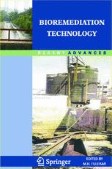Search
Search Results
-
Response of marine bacterioplankton pH homeostasis gene expression to elevated CO2
Human-induced ocean acidification impacts marine life. Marine bacteria are major drivers of biogeochemical nutrient cycles and energy fluxes
1 ; hence,...
-
Novel Insights on the Symbiotic Interactions of Marine Sponge-Associated Microorganisms: Marine Microbial Biotechnology Perspective
Marine sponges are the most dominant group responsible for discovering a large number of natural products that have been used as template to develop...
-
Microbial metagenomics in the Baltic Sea: Recent advancements and prospects for environmental monitoring
Metagenomics refers to the analysis of DNA from a whole community. Metagenomic sequencing of environmental DNA has greatly improved our knowledge of...

-
Molecular approaches for biodegradation of polycyclic aromatic hydrocarbon compounds: a review
The waste generated from industrial processes and operations including domestic wastes when treated partially and disposed in soil–water environment...

-
Proteomic tools to decipher microbial community structure and functioning
Recent advances in microbial ecology allow studying microorganisms in their environment, without laboratory cultivation, in order to get access to...

-
From humic substances to soil organic matter–microbial contributions. In honour of Konrad Haider and James P. Martin for their outstanding research contribution to soil science
PurposeMany decades of research have shown that humic compounds as part of the soil organic matter (SOM) are essential for the stability and...

-
Metagenomic Approaches in Understanding the Rumen Function and Establishing the Rumen Microbial Diversity
Livestock production in develo** countries is subsidiary to plant agriculture. In tropical countries, ruminants are fed on lignocellulosic...
-
The integration of sequencing and bioinformatics in metagenomics
Since most microorganisms in natural environments cannot be cultured in laboratory media, due to low growth rates or their dependency on specific...
-

-
The impact of temperature on marine phytoplankton resource allocation and metabolism
Marine phytoplankton are responsible for ∼50% of the CO 2 that is fixed annually worldwide, and contribute massively to other biogeochemical cycles in...

-

-
Conclusions
This book is aimed at a systematic description of the knowledge accumulated on studying of chemical structure of pelagic redox interfaces, oxygen...
-
Nitrification activity and putative ammonia-oxidizing archaea in acidic red soils
PurposeAcidic red soils account for 21% of land area in China and contain low ammonia concentration due to ionization to ammonium. The unusual high...

-
Molecular Techniques to Assess Microbial Community Structure, Function, and Dynamics in the Environment
Culture-based methods are important in investigating the microbial ecology of natural and anthropogenically impacted environments, but they are...
-
Key Biochemical Attributes to Assess Soil Ecosystem Sustainability
Soil is not a renewable resource, at least within the human timescale. In general, any anthropic exploitation of soils tends to disturb or divert...
-
The Energetic Balance of Microbial Exploitation of Pelagic Redox Gradients
In marine environments and especially in marginal seas, pelagic redox gradients with underlying sulfidic water layers are a known phenomenon. General...
-
Bioremediation of Mangroves Impacted by Petroleum
The majority of oil from oceanic oil spills (e.g. the recent accident in the Gulf of Mexico) converges on coastal ecosystems such as mangroves....

-
A comprehensive overview of elements in bioremediation
Sustainable development requires the development and promotion of environmental management and a constant search for green technologies to treat a...

-
Genomics Approach to Bioremediation
A range of pollutants are being added to the environment by human activities. Majority of these contaminants are chemically synthesized compounds...
